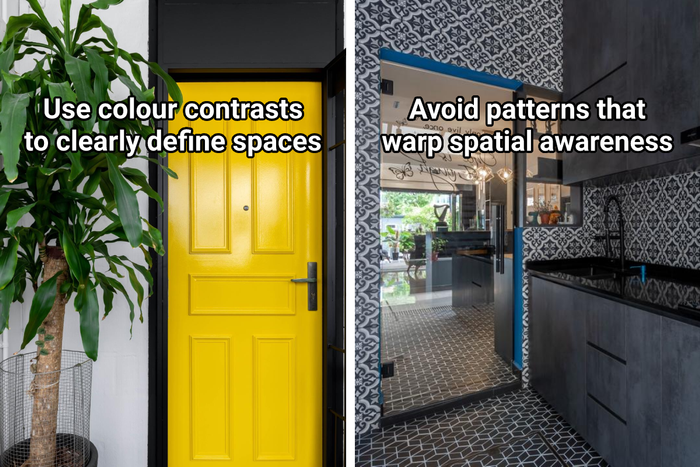Helping persons living with dementia live independently while keeping them safe.
Everyday things like moving around the house or locating your belongings may seem simple – but to a person living with dementia, symptoms such as disorientation and short-term memory loss may make these tasks extra challenging.

So, how can a home be designed in a way that allows them to move around independently while still keeping them safe? Or rather, what does a dementia-friendly home really entail? We spoke to Ms Koh Hwan Jing, an occupational therapist of over 20 years and the Director of Community Enablement at Dementia Singapore, to find out more.
1. How does dementia affect a person’s day-to-day life?

Hwan Jing (HJ): A person living with dementia tends to be fairly forgetful, as they experience short-term memory loss. They cannot recall recent events, and they also gradually lose their sense of time, where they are unable to know what day, month, or year it is.
Persons living with dementia who experience symptoms of disorientation may also have a weaker sense of spatial awareness and will rely heavily on visual cues. They may also find it difficult to navigate past obstructions such as furniture and steps, which can become potential risks to their safety.
To experience the challenges faced by a person living with dementia, head over to Experience Dementia in Singapore to find out more.
2. How can a home be designed in a way that mitigates these challenges? For instance, are there specific colours you should use (or avoid) to make a home more dementia-friendly?
HJ: Generally, the colours should evoke the right ambience according to the function of the space. For example, pastels or natural wood tones are relaxing and work well in the living room, while colours like red are said to stimulate brain activity and appetite, and work well in the dining room.

Use different colours for the floor, walls, and doors to help a person living with dementia distinguish between the two | View this project by Inizio Atelier
What is important, though, is contrast. It’ll help them tell the difference between items and spaces, and is especially useful for those living with visual-spatial impairment.
For example, you can use a brighter toilet seat against a toilet bowl to help them locate it more easily, or stick yellow tape around the edge of steps to help them see where they start and end – just be sure to replace the tape once it wears out. You can also include anti-slip mats of a contrasting colour for additional fall protection.

Patterns or colours that are too similar can confuse a person living with dementia, especially those with impaired visual-spatial awareness | View this project by Concrid Interior
As much as possible, avoid using patterns, as it can confuse them. Wallpaper with patterns, for example, warps their sense of visual-spatial awareness, and may also be perceived as moving objects.
3. What about materials? What should you keep in mind when designing a dementia-friendly home?

Install see-through cabinets if you can. If that’s not possible, label them and use big knobs/handles | View this project by Key Concept
HJ: When choosing materials, the main principle is to choose something non-slip (to prevent falls) and non-reflective. Light reflecting off a glossy floor or kitchen countertop may seem like puddles of water to a person living with dementia, which can cause fear and make them reluctant to walk around the house.
So, as much as possible, choose something matte, and avoid materials like marble. If you’re looking at tiles, plain ones are okay, but do try not to pick those with patterns, as they may confuse the person living with dementia.
Additionally, dark coloured rugs and tiles adjacent to light-coloured flooring can look like holes in the ground, so you may want to avoid that as well.
4. How about fittings such as taps and door knobs?
HJ: As people living with dementia tend to be over 65 years old, you should look at incorporating elderly-friendly features. If they have medical conditions that affect their hands (like arthritis or stroke), get a levered door handle instead of a rounded door knob as it’s easier to hold. Similarly, they may also find it easier to use taps with levers.

Keep items that the person living with dementia frequently engages with near their bed (e.g. comb, photos, etc.) | View this project by Renex Interior
If the person living with dementia is no longer able to discern what’s safe to use, you may want to consider keeping appliances out of their reach, or covering power points or wires. Some families I’ve worked with have put a plastic cover over their power points to minimise access and risk.
For people with impaired mobility, install a few grab rails where falls can happen – like the bathroom or near a curb, for example. The best position of these grab rails differ depending on the individual’s height and abilities, so it’s best to consult an occupational therapist for the measurements. You may engage an occupational therapist at hospital-based outpatient clinics, or via home therapy services like TOUCH Home Care.
Smart home appliances can also be useful, since household members can’t physically be with them 24/7. Fixtures like motion-sensing lights are great for those who forget to turn off the light.
5. For homeowners not looking to renovate, what are some things they can do to make their home more dementia-friendly?

Objects like clocks and photos can be particularly useful for a person living with dementia
HJ: Putting calendars or clocks around the house can help a person living with dementia keep track of time. You can also place newspapers or puzzles in an easily accessible place, or put up photos of family members or past events to keep them mentally engaged.
They may also have trouble locating their room or their things, so try labelling cabinets or placing signages that say ‘bedroom’ to help them out.

Side tables are ideal as the person living with dementia can have mentally-stimulating items like their phone or puzzle books within arm’s reach | View this project by Brick & Decor
It goes without saying, of course, but you should also strive to minimise clutter. Aside from removing trip risks like wires or cables, putting things at the same place all the time will help. It seems like a small thing, but it helps the person living with dementia know where everything is at all times, and will help build independence.
6. What are some words of advice for homeowners who live with a person of dementia?

Avoid glossy finishes for the floor as they can be perceived as puddles of water by the person living with dementia | View this project by Cubetopia
HJ: Living with a person with dementia involves striking a balance between keeping them safe, but also allowing them to remain independent. If you restrict their movement too much, where they’re unable to do anything, there’s an increased risk of muscle wastage, weakness, etc. But if you let them roam freely without any safeguards in place, there’s a high chance that they can hurt themselves.
It’s important to remember that, as much as you want to be there for them, there’s only so much you can do. The best way to help them is through little modifications around the home. And if you feel out of your depth, please don’t be afraid to get help – be it from other family members or organisations such as the Agency for Integrated Care and Dementia Singapore.
Here’s how to make a home more dementia-friendly
If you want to find out how else to make your home more dementia-friendly, The Agency for Integrated Care (AIC) and Dementia Singapore has co-developed a 360º Virtual Reality Dementia-Friendly HDB Home Design Guide that contains practical home modification tips to create a dementia-friendly home.
For even more information, online resources like DementiaHub.SG and CARA, Dementia Singapore’s lifestyle and community digital platform, have a comprehensive collection of useful resources and tips to support caregivers and persons living with dementia.

 Get a budget estimate before meeting IDs
Get a budget estimate before meeting IDs